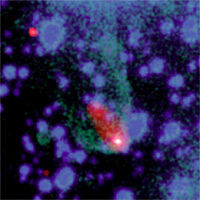
Printed from: PhysLink.com; https://www.physlink.com/news/Index.cfm?ID=8
Original publication date: Monday March 3, 2003.
A Cocoon Found Inside the Black Widow's Web
 Credit: X-ray: NASA/CXC/ASTRON/B.Stappers et al., Optical: AAO/J.Bland-Hawthorn & H.Jones |
Known officially as pulsar B1957+20, the Black Widow received its nickname because it is emitting intense high- energy radiation that is destroying its companion through evaporation. B1957+20, which completes one rotation every 1.6-thousandths of a second, belongs to a class of extremely rapidly rotating neutron stars called millisecond pulsars.
The motion of B1957+20 through the galaxy, almost a million kilometers
per hour, creates a bow shock wave visible to
optical telescopes. The Chandra observation shows what
cannot be seen in visible light: a second shock wave. This
secondary shock wave is created from pressure that sweeps
the wind back from the pulsar to form the cocoon of high-
energy particles, visible for the first time in the Chandra
data.
"This is the first detection of a double-shock structure around a pulsar," said Benjamin Stappers, of the Dutch Organization for Research in Astronomy (ASTRON), lead author on a paper describing the research that will appear in the Feb. 28, 2003, issue of Science magazine. "It should enable astronomers to test theories of the dynamics of pulsar winds and their interaction with their environment," he said.
Scientists believe millisecond pulsars are very old neutron
stars that have been spun up by accumulating material from
their companions. The steady push of the infalling matter
spins it much the same way as pushing on a merry-go-round
makes it rotate faster.
The result is an object about 1.5 times as massive as the
Sun, 10 miles in diameter, rotating hundreds of times per
second. The advanced age, very rapid rotation rate and
relatively low magnetic field of millisecond pulsars put
them in a totally separate class from young pulsars observed
in the remnants of supernova explosions.
"This star has had an incredible journey. It was born in a
supernova explosion as a young and energetic pulsar, but
after a few million years grew old and slow and faded from
view," said Bryan Gaensler of the Harvard-Smithsonian Center
for Astrophysics in Cambridge, Mass., a coauthor of the
paper. "Over the next few hundred million years, this dead
pulsar had material dumped on it by its companion, and the
pulsar's magnetic field has been dramatically reduced.
"This pulsar has been through hell, yet somehow it's still
able to generate high-energy particles just like its younger
brethren," continued Gaensler. The key is the rapid rotation
of B1957+20. The Chandra result confirms the theory that
even a relatively weakly magnetized neutron star can
generate intense electromagnetic forces and accelerate
particles to high energies to create a pulsar wind, if it is
rotating rapidly enough.
Chandra's Advanced CCD Imaging Spectrometer observed
B1957+20 for more than 40,000 seconds on June 21, 2001.
Other members of the research team include Victoria Kaspi
(McGill University, Montreal), Michiel van der Klis
(University of Amsterdam, Netherlands) and Walter Lewin
(Massachusetts Institute of Technology, Cambridge).
NASA's Marshall Space Flight Center, Huntsville, Ala.,
manages the Chandra program. TRW, Inc., Redondo Beach,
Calif., is the prime contractor for the spacecraft. The
Smithsonian's Chandra X-ray Center controls science and
flight operations from Cambridge, Mass., for the Office of
Space Science at NASA Headquarters, Washington.
Images and additional information about this result are available
on the Internet at:
http://chandra.harvard.edu, and
http://chandra.nasa.gov
![]()
News Story Origin and Copyright:
NASA/Chandra : http://www.nasa.gov
Original news release:
http://www.nasa.gov/HP_news_03081.html
![]()
For more physics & astronomy stories like this one, go to: physlink.com